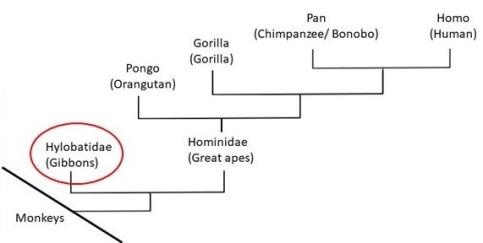Background and Aims
General information about gibbons
- Gibbons (Hylobatidae) are the sister group of the great apes (Hominidae)
- There are currently 20 recognized species in 4 monophyletic genera
- Natural habitat: Tropical rainforests in Southeast Asia
- Populations in the wild are drastically declining
- Main threats:
- Habitat loss due to deforestation, forest fires, oil palm plantations
- Habitat fragmentation
- Air pollution caused by forest fires
- Hunting for sport and food purposes, and for the illegal pet trade
- Gibbons live in small family groups and are socially monogamous
- Gibbons are highly territorial and are known for their song bouts to, amongst others, defend their territory-boundaries and to announce themselves to adjacent gibbon-groups
Why study gibbons?

Investigating great apes has long been of special interest because this knowledge could shed light on evolutionary processes and even help understand the origin and development of human kind, and primates in general. Gibbons are particularly interesting based on their proximity to the great apes and them being phylogenetically intermediate between the great apes and monkeys.
What do we know about gibbon cognition?
- Tool-use
- Rake to obtain food that was out of reach (Cunningham et al., 2006)
- Piece of cloth as a sponge to collect water for drinking purposes (Rumbaugh, 1970)
- Door-slamming to alter and accentuate a particular phrase of a morning song bout (Geissmann, 2009)
- Theory of mind
- Self-awareness is a controversial topic; pros and cons have been provided (Hyatt, 1998; Ujhelvi at al., 2000; Heschl and Fuchsbichler, 2009; Suddendorf and Collier-Baker, 2009)
- Ability of detecting and understanding visual directional cues from others has been shown to exist (Inoue et al., 2004; Horton and Caldwell, 2006)
Social brain hypothesis
According to the “social brain hypothesis” or “Machiavellian intelligence”- hypothesis, cognitive abilities are constrained by the complexity of the animals’ social life (Humphrey, 1976; Dunbar, 1998).
Cooperative behaviours
Cooperation = “The behaviour of two or more individuals acting together to achieve a common goal” (Boesch and Boesch, 1989). Furthermore, the individuals are “in a situation in which neither can benefit alone, or at least not to the same degree, as when they act in concert” (Tomasello and Call, 1997).
Cooperation plays a crucial role in social interactions and several species have already been shown to display cooperative behaviours among each other, e.g.:
- Chimpanzee (Pan troglodytes) (Boesch and Boesch, 1989; Boesch, 1994)
- Bonobo (Pan paniscus) (Hare et al., 2007)
- Gorilla (Gorilla gorilla) (Sicotte, 1993)
- Bornean orangutans (Pongo pygmaeus) (Chalmeau et al., 1997; Völter et al., 2015)
- Asian elephants (Elephas maximus) (Plotnik et al., 2011)
- Bottlenose dolphins (Tursiops truncatus) (Kuczaj et al., 2015; Eskelinen et al., 2016)
- Wolves (Canis lupus) (Marshall-Pescini at al., 2017)
- Spotted hyaenas (Crocuta crocuta) (Drea and Carter, 2009)
- Rooks (Corvus frugilegus) (Seed et al., 2008)
- African grey parrots (Psittacus erithacus) (Péron et al., 2011)
Aims
- To investigate whether or not gibbons cooperate with each other during a problem-solving task
- To test the “social brain hypothesis” in order to confirm or deny if the complexity of animals’ social life could be indicative for their cognitive abilities
Responsible for this page:
Director of undergraduate studies Biology
Last updated:
06/02/18
